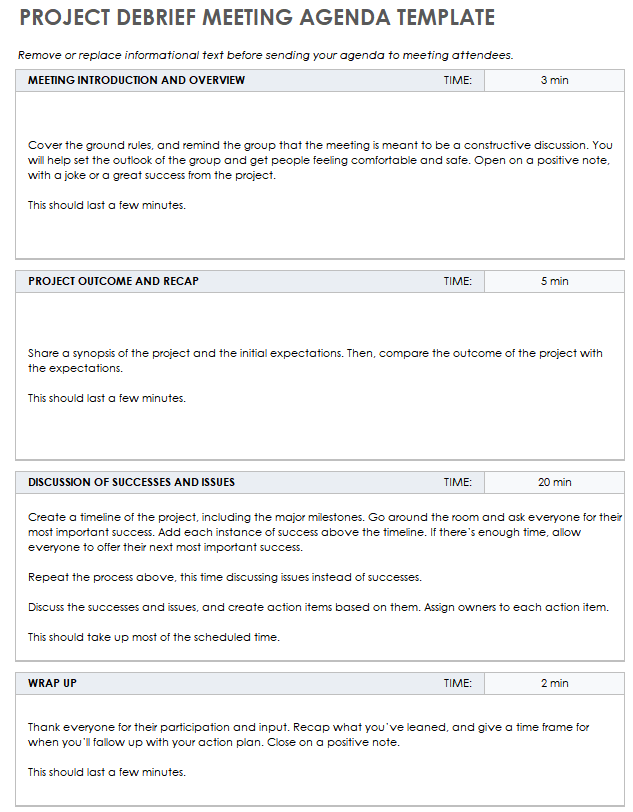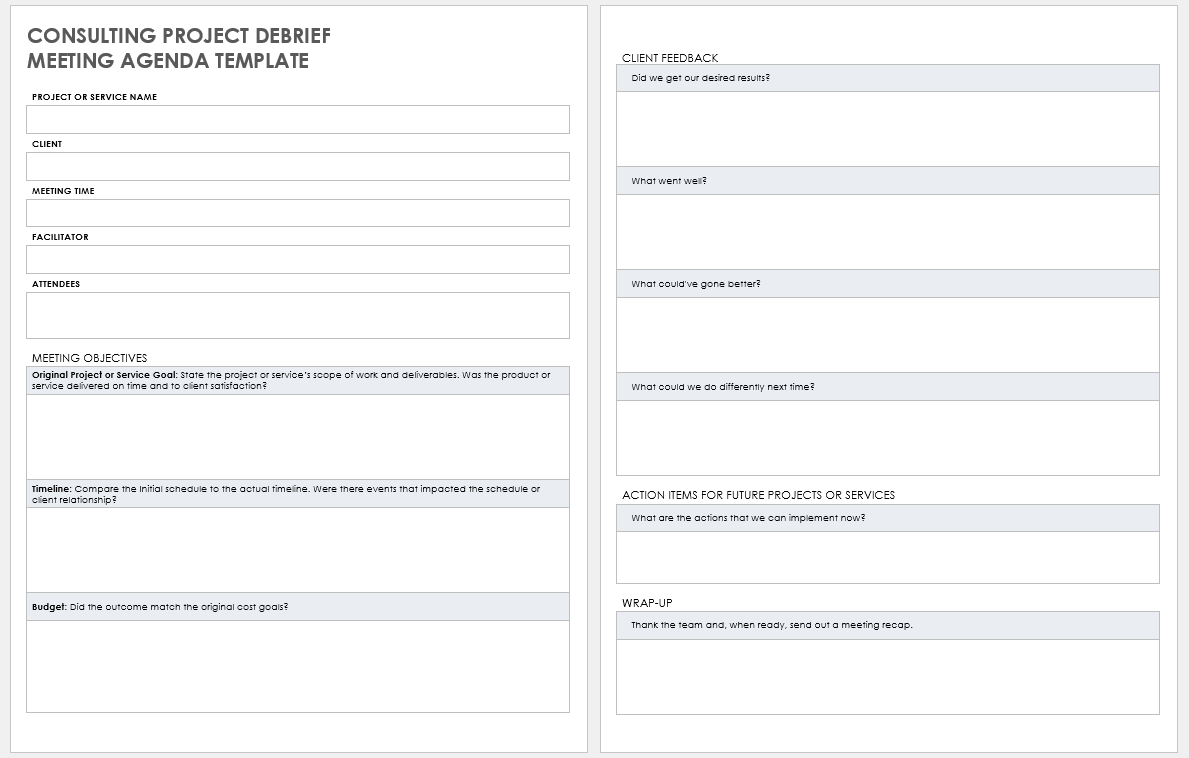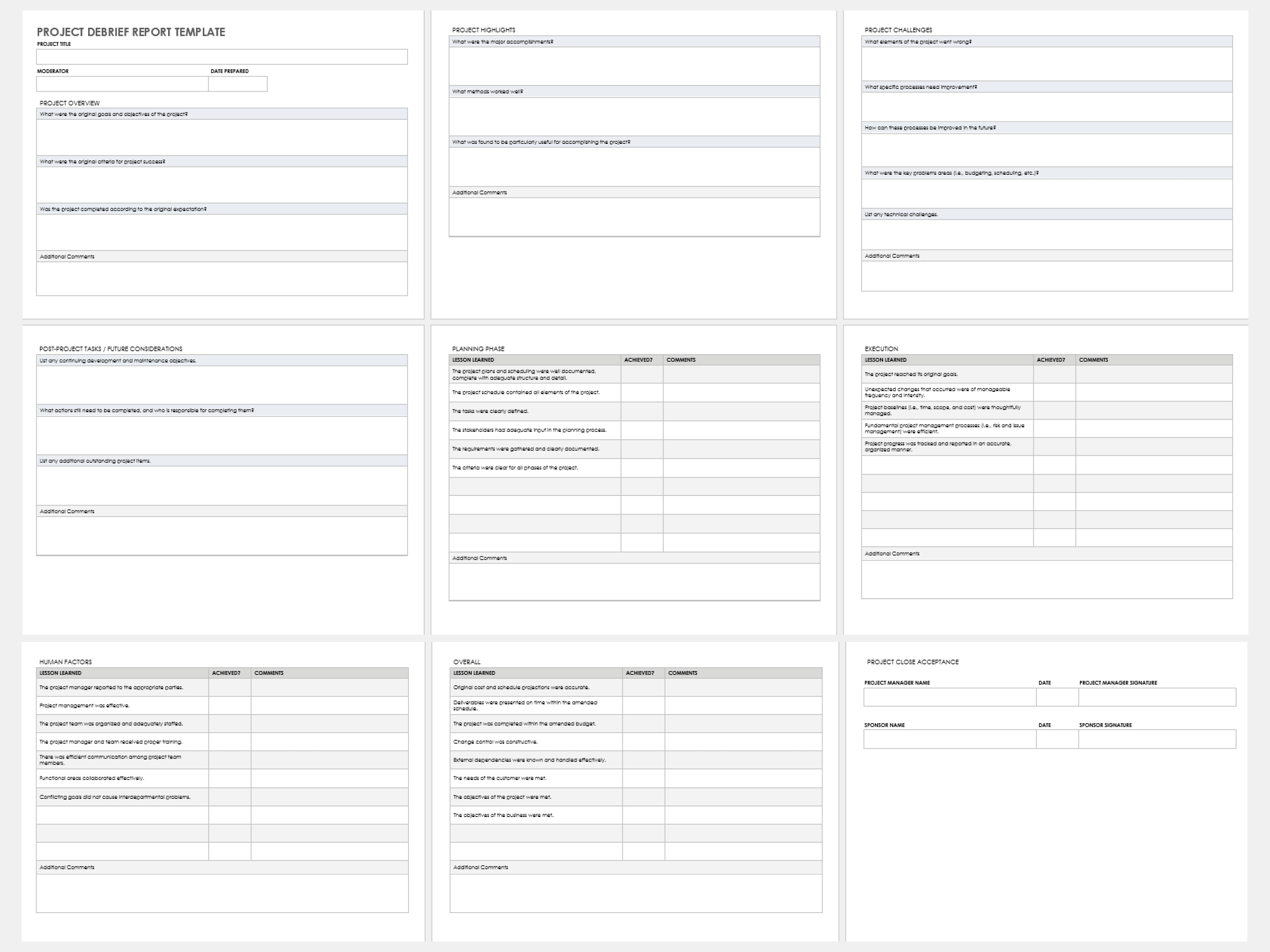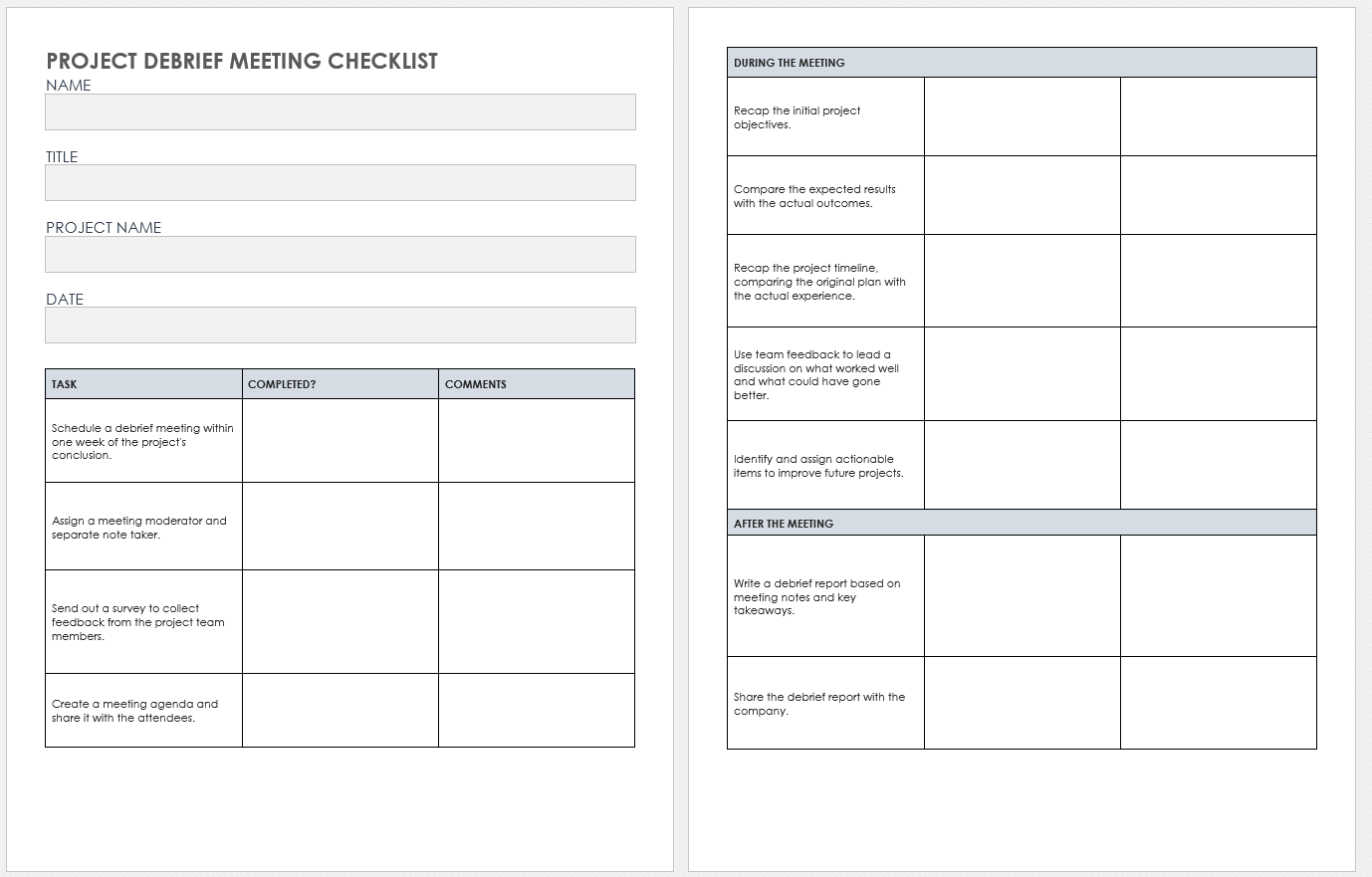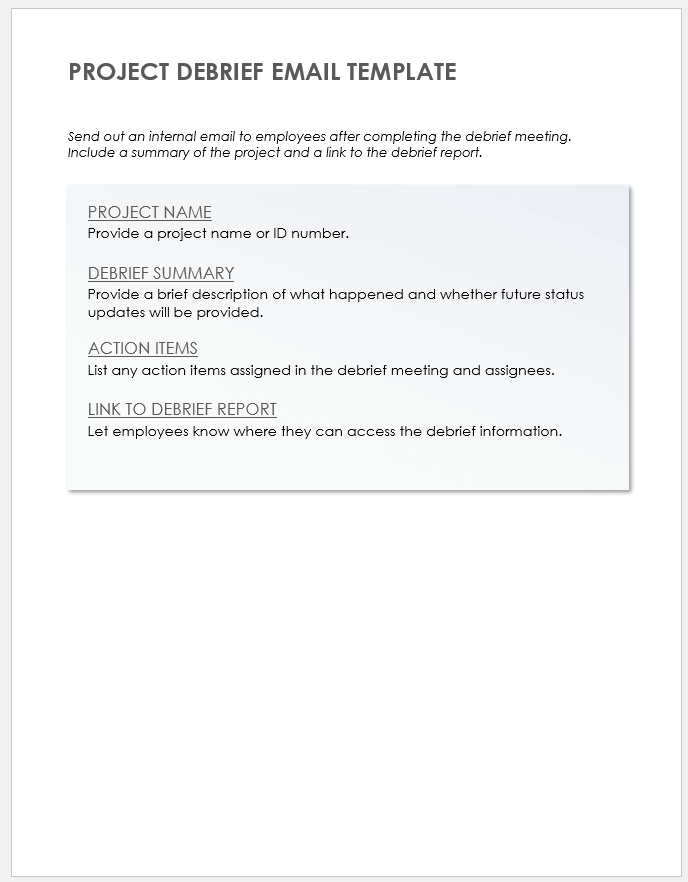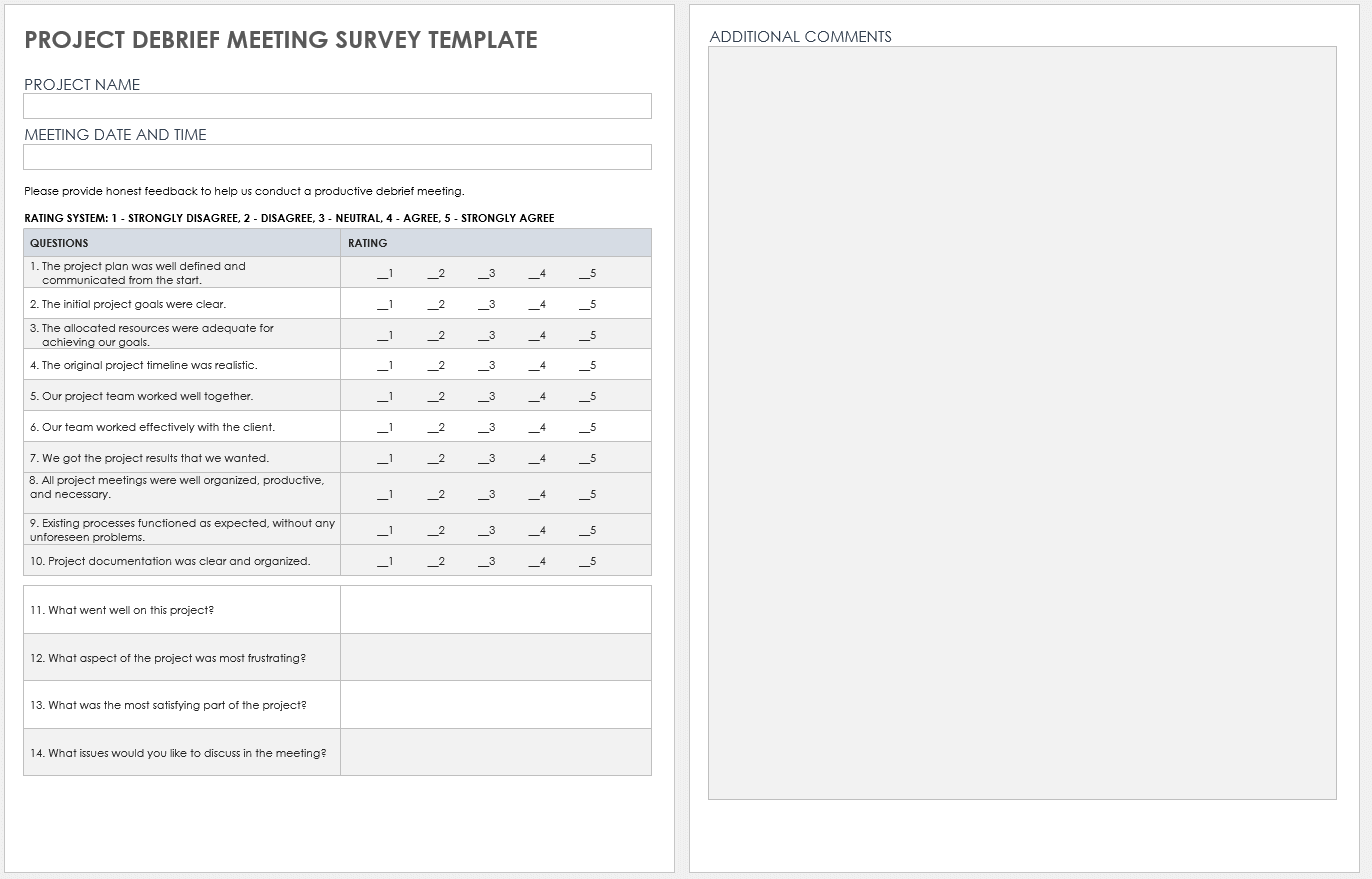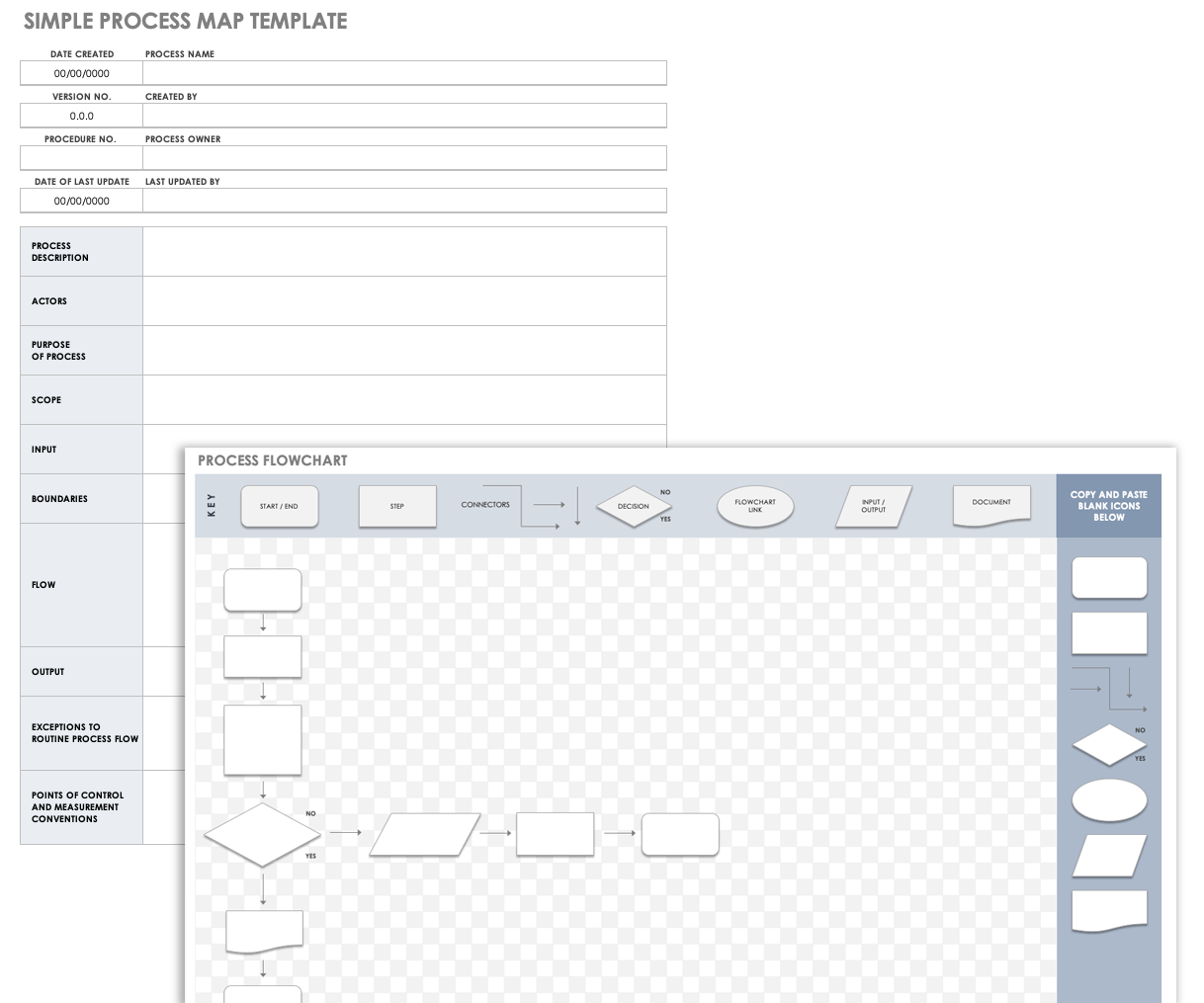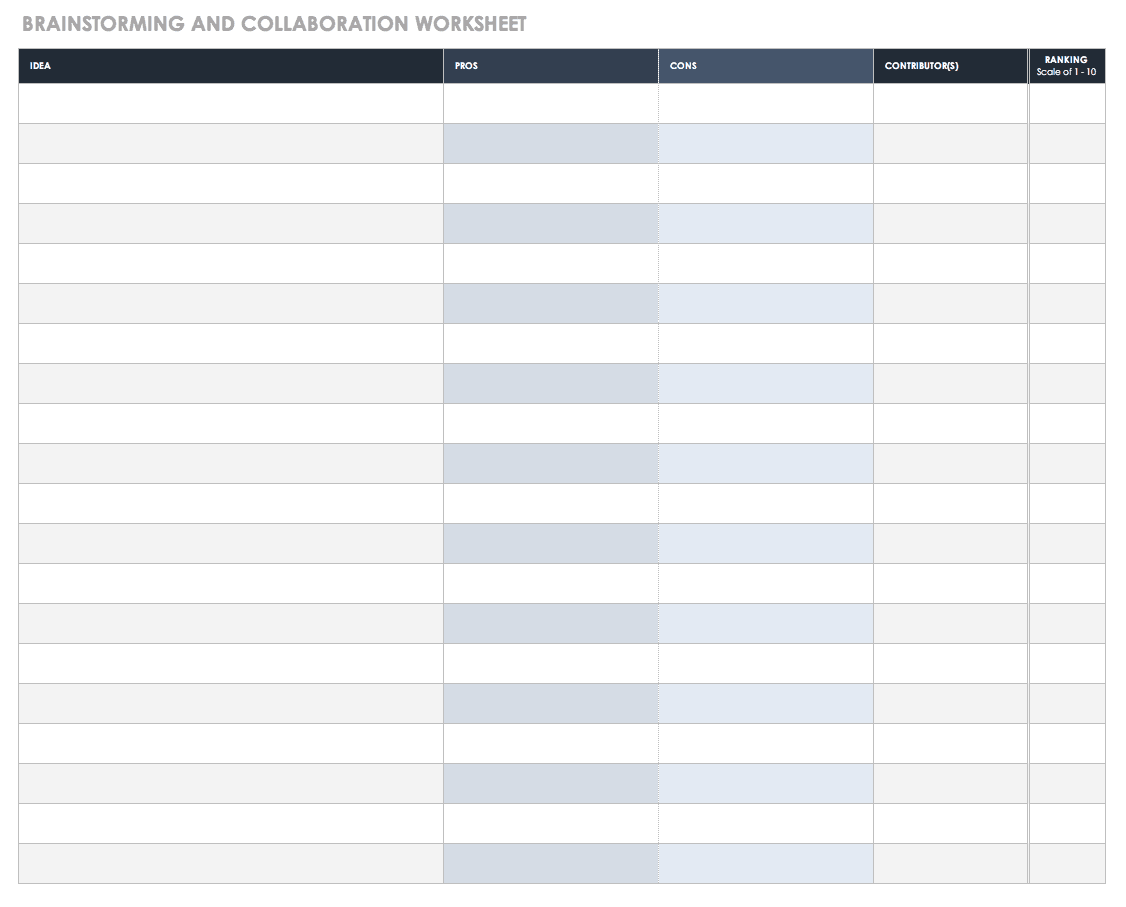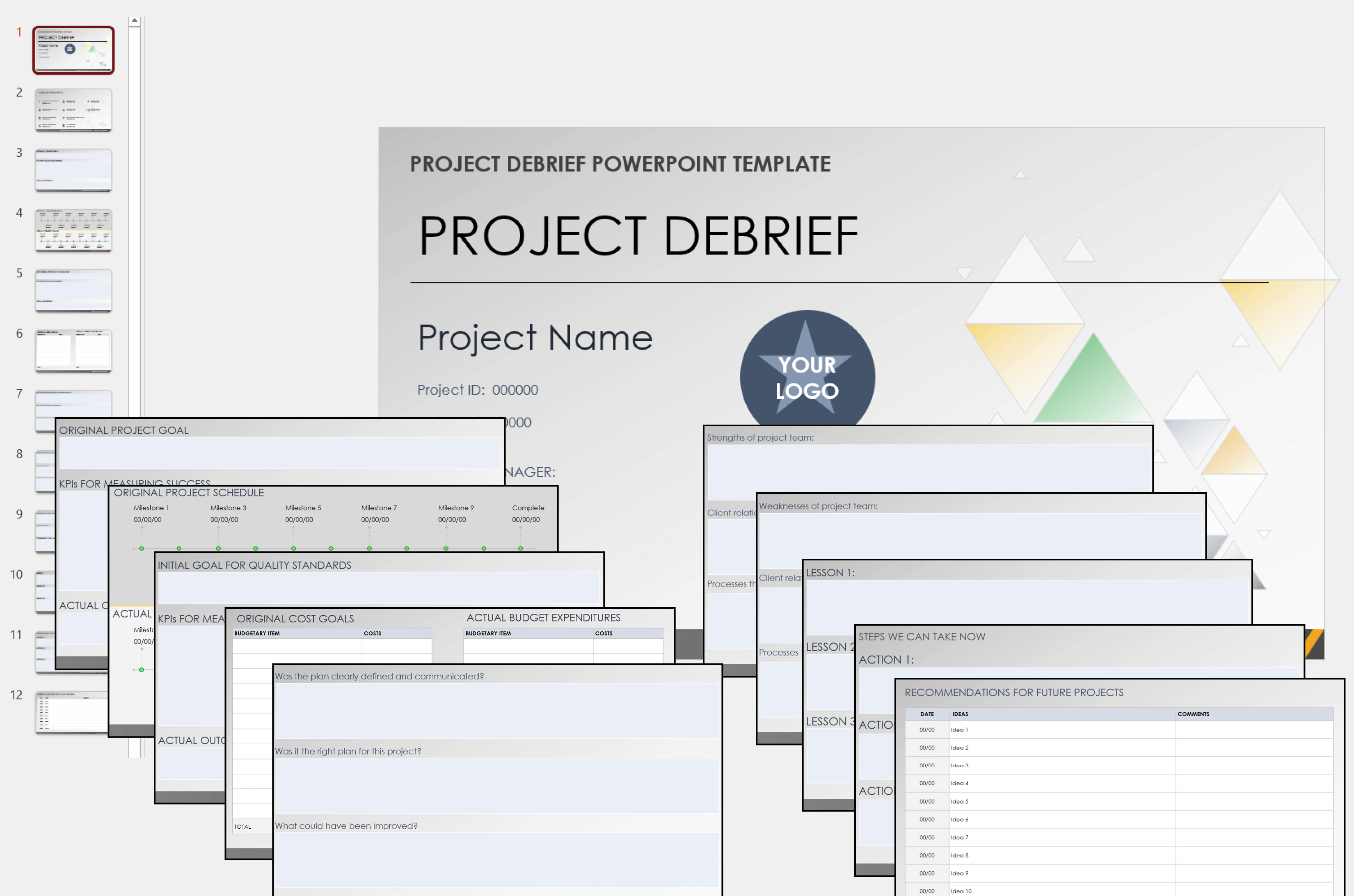What Is a Project Debrief?
A project debrief is a meeting where teams review and analyze a project either periodically or after completion. Conduct project debriefs to determine what did and didn’t work, and to learn how to improve the outcomes of future projects.
It is important that everyone who worked on a project is involved in a project debrief meeting. Project debrief moderators should encourage everyone to give feedback on their experience and ideas. “The project investors, manager, team, and anyone else vested in the project should attend the debrief,” advises Roy Morejon, President and Co-Founder of Enventys Partners. “This ensures everyone has a chance to understand the results of the project and ask questions in a public forum.”
For shorter projects, project managers might hold a single project debrief as part of the project closeout process. For larger projects, debrief meetings should occur at regular intervals throughout the lifecycle of the project.
“In my experience, having a few checkpoint project debriefs in addition to a final project debrief throughout the lifecycle is helpful,” says Samantha Crunkilton, Catalog Content Manager for Cheetah Technologies. “If you wait until the very end and do one large debrief, the amount of information can be overwhelming to the stakeholders. Also, you could find that you missed or didn’t understand something correctly, and it may be too late to resolve or change course at that point.”
The term debrief originated in the military, where mission debriefs are used to mitigate the emotional and psychological impact of stressful events. In project management, a debrief meeting has many common names, such as a project retrospective or a project post-mortem.
These are some common terms that all describe the post-project meeting:
| Term | Common Industries |
|---|---|
After-action review |
IT and software development |
Critical incident review |
IT and software development |
Learning review |
All industries |
Lessons learned meeting |
Project Management Institute (PMI) |
Post-mortem |
All industries |
Project debrief |
Military; psychological research; crisis intervention; business |
Project wrap-up |
All industries |
Retrospective |
Agile project management |
For more resources on project post-mortems, see this helpful collection of post-mortem templates and this guide to running a post-mortem.
Main Purpose of a Project Debrief
The main purpose of a project debrief is to identify what caused a project’s successes and failures. Teams can use the meeting to learn from past projects and to improve internal processes and communication.
Debrief meetings offer a relaxed environment to review facts and exchange ideas after the stress of a project is over. For projects that go well, a project debrief is an opportunity to identify processes that worked well, make incremental improvements, and celebrate success. For projects that don’t go well, a project debrief is a chance to identify what went wrong, suggest process adjustments, and keep morale high after a setback.
These are the main reasons that project managers hold project debrief meetings:
- Celebrate Success: While it is exciting to have worked on a successful project, it can dampen morale over time if those successes go unacknowledged. Use a project debrief to recognize your team’s hard work after a major win.
- Conclude a Project or Project Phase: It can be difficult to focus on the next project or project phase if team members are still unsure of how the previous project or phase went. Create a clear distinction between projects or phases of a project.
- Encourage Collaboration: An open dialogue among team members helps build a collaborative work culture. Improve team cohesion by holding regular project debriefs.
- Encourage Innovation: Sometimes incremental adjustments aren’t enough to address major process issues. In these cases, use the project debrief to brainstorm ideas and consider creating new processes from the ground up.
- Evaluate Cohesiveness: Some project setbacks are caused by process inefficiencies, while others are simply a result of poor communication or tense working relationships. The debrief can help expose conflicts that need to be resolved.
- Identify Risks: Reviewing the entire project will help you identify risks that you didn’t foresee in the project planning phase. Use these lessons to better identify and mitigate risks for future projects.
- Improve Morale: An unsuccessful project can be demoralizing. Boost morale by focusing on what lessons have been learned and being solution oriented.
- Improve Processes: By openly discussing the project, team members can better identify inefficiencies and error-prone processes. Update processes based on the lessons learned in your project debrief.
- Learn from Mistakes: Identifying mistakes is not about assigning blame. Pinpoint problems so that team members can avoid them in the future. Teams should always leave a project debrief with actionable takeaways.
- Provide Documentation: Proper documentation helps ensure that companies can track project successes and failures over time. Document project debriefs for future reference.
- Share Information: Team members might have differing views on what happened during the project. Provide space for everyone to share their perspectives and insight.
Project leaders can also get creative and customize project debrief meetings to fit their needs. Crunkilton shares her experience using a project debrief to adjust course on a systems implementation project.
“We had faced some challenges and issues with processes working as expected when the users started doing testing,” she explains. “During the next project debrief, I changed course a little bit and scheduled a system demo during the debrief. Allowing the key stakeholders on the team to see the system helped with training the users and improving morale and confidence that the system would be able to meet their needs.
“It also improved communication across the team because I was speaking in their language and processes rather than on a more technical level. Going forward, I was able to schedule more demos with the users since they found it helpful. I also recorded those sessions, which allowed them to go back and watch the recording rather than having to ask the same questions multiple times. This improved communication and morale between the teams because there was less frustration in the communications.”
How to Debrief a Project
A successful project debrief is an inclusive meeting. Invite all team members, managers, and stakeholders who are involved in the project. Assign roles such as a third-party moderator and notetaker. Lastly, wrap up the meeting with actionable takeaways.
Project debriefs should be a regular part of all projects. For shorter projects, schedule the meeting within a week of the project’s end. For longer or more complex projects, schedule periodic debrief meetings. These might be held monthly, weekly, or at the conclusion of different project phases. “I managed a project where we split it up into different processes, and we considered each process a phase of the project,” says Crunkilton. “Having closure on one phase before moving onto the next one helps the team celebrate success for completion, and it allows a natural break between phases.”
Before the project, distribute a survey, or feedback form, to all team members, project sponsors, clients, managers, and anyone else who is vested in the project. Use the survey responses to create a meeting agenda. “It is crucial to share the agenda with the attendees prior to the meeting,” explains Crunkilton. “This allows them time to review and come prepared with questions or any thoughts or concerns that they have about the project.”
Finally, assign someone to be a notetaker and a neutral third party to be the moderator. Amy David, Clinical Associate Professor at Purdue University’s Krannert School of Management, stresses the importance of assigning a third-party facilitator. “Get a neutral facilitator who is not the project manager or a member of the project team,” she advises. “An experienced project manager from elsewhere in the organization or a training and development manager could be a good choice. This person can help take some of the emotion out of the meeting and redirect any lines of discussion that start to assign blame for any issues encountered on the project.”
For more project debrief resources, see this comprehensive collection of project debrief templates.
Step-by-Step Guide to Project Debriefs
All project debriefs follow the same basic structure. Important steps include distributing a feedback survey and creating a meeting agenda. During the meeting, set expectations, assign actionable takeaways, and document a final project summary.
Before your project debrief meeting, complete each of the following steps:
- Schedule: Set up a meeting within a week of project’s end. For longer projects, put several intermittent debrief meetings on the calendar. “When I am leading a project, I always schedule multiple project debrief sessions during its lifecycle to minimize risks associated with missing key aspects or resolving barriers and misunderstandings across stakeholders,” shares Crunkilton.
- Assign Roles: Be sure to invite everyone involved in a project along with a neutral facilitator to lead the discussion. This might be another project manager or a development manager from elsewhere in your organization. Finally, assign a notetaker who can record the meeting and type up a summary.
- Distribute Survey: Send a survey to team members prior to the debrief meeting. This survey should have space for team members to provide feedback and include questions that help gauge what did and did not work well in the project.
- Develop Agenda: Review survey responses, and identify common themes and frustrations. Use this information to create a meeting agenda and to draft questions for discussion. Distribute the agenda to attendees a day or two prior to the meeting so that team members can review and prepare.
- Prepare Feedback: Crunkilton recommends all attendees – from project managers to team members – review the agenda prior to the meeting. “For the parts that I specifically worked on, I ensure that I have information, questions, and status updates on everything prior to the meeting,” she says. “I also try to pay attention to the time allotted for that part of the project during the discussion. That helps me determine the level of detail to share with the full group or whether I need to send out a detailed explanation prior to the meeting.”
Once the meeting begins, follow these steps to keep your team focused and organized:
- Set Expectations: Establish the tone of a constructive, objective meeting. Clarify what you will discuss and outline the meeting’s goals. “When the stakeholders come to the meeting with their mind already made up that it is a project that they don’t support or don’t have confidence that it is successful, it can make the project debrief counterproductive,” warns Crunkilton. “It is important to set the tone at the beginning of the debrief and help to hold each other accountable during the meeting to keep everyone focused on the bigger picture.”
- Recap Project: Focus the discussion by beginning with a basic summary of project goals and outcomes.
- Review Expectations and Outcomes: Run through the list of expectations and goals that were set out in the project plan. Compare those with actual outcomes. This review should encompass all parts of a project, including expected and actual timeline, budget, resource allocation, accomplishments, and standards of achievement.
- Lead Discussion: Using the survey responses and meeting agenda as a guide, lead a discussion about the project. Focus on identifying not only what went wrong, but why. Brainstorm solutions, and encourage everyone to participate and provide feedback.
- Wrap Up: End the meeting by recapping key takeaways from the discussion. Identify and assign action items so that team members leave with a clear understanding of what to do next.
Ensure that your project debrief meeting ends on the right note by following these final, post-meeting steps:
- Write a Report: Request a detailed report of the meeting from the assigned notetaker type, or use their notes to write a summary. Include key discussion points, identified areas for improvement, and actionable takeaways.
- Distribute Report: Be sure to circulate the report to all attendees. Also, file the report where it can be easily found for future reference.
What to Include in a Project Debrief
A project debrief should help you analyze a project’s successes and failures and apply those lessons to future ventures. Some elements to include are a pre-meeting survey, a project overview, and questions.
Every project manager should include these components in their project debrief:
- Pre-Meeting Survey: Prior to the debrief meeting, distribute a survey to all team members and stakeholders. The survey should allow everyone to rank the success or failure of different aspects of the project. Was the timeline realistic? Were the original project goals clear? Did the team work well with the client? Allow space for team members to identify aspects of the project that were frustrating or satisfying and the reason why.
- Meeting Agenda: Based on the survey answers, develop a project debrief meeting agenda to distribute to attendees prior to the meeting. Include priority topics, questions to address, and the basic structure of the debrief meeting.
- Project Recap: Project debriefs begin with a recap of the project’s initial goals and anticipated timeline and budget. Compare these expectations with the actual outcome of the project. This recap should set the tone of the meeting and help focus the upcoming discussion.
- Prepared Questions: Meeting organizers should prepare questions that encourage an open dialogue among participants. The most useful questions are those that help the team understand what happened, what lessons can be learned, and what the team might do differently next time.
- Open Discussion: All team members are encouraged to participate by providing insights and feedback, suggesting process changes, and brainstorming new ideas. “Another tip for identifying why something went wrong is to diagram a process map and identify any gaps within that process,” says Crunkilton. “To prevent issues from happening again, it is crucial to understand the cause and implement a process to avoid or reduce the risk.”
Use one of the process map templates to determine process gaps. - Wrap-Up: Conclude the debrief meeting with a review of the covered topics and a list of actionable items that team members can pursue. Send meeting notes and actions items to all attendees.
15 Project Debrief Questions
Thoughtful, productive questions are the basis of any successful project debrief. Develop questions that will help your team identify what happened. Focus on lessons they can learn and what they might do differently next time.
Here are some questions you might include in your next project debrief:
- Goals: What were the primary and secondary goals of this project? Did we meet these goals? Did we achieve what we set out to achieve? Identify discrepancies between your expectations for the project and the actual results.
- External Performance: Was the client happy? Did the project meet client expectations? It might also be helpful to distribute a survey to clients and review their responses for a more objective analysis.
- Internal Performance: Were there clear success metrics? Were they realistic? Adjust or clarify your success metrics for future projects.
- Project Plan: Was the initial project plan missing important information? Were all necessary tasks, dependencies, and contingencies accounted for? Take note of any surprises that came up during the project.
- Team Cohesion: Were there communication breakdowns or tension among team members? Was the distribution of work fair? Look for sources of tension or conflict so that you can find realistic solutions.
- Resources: Were materials, equipment, budget, and team members allocated correctly? Did available software function as needed? Pinpoint any delays or errors that could have been prevented with additional resources or better allocation.
- Past Projects: Was this project more or less successful than other projects we’ve completed? Compare processes and outcomes, and brainstorm reasons this project might have fared better or worse.
- Tasks: Were all tasks accounted for in the initial plan? Was enough time allotted to complete each task? Identify tasks required for project completion but were not included in your initial plan.
- Management: Did management interfere with or obstruct work? Was communication between team and management open and clear? Project managers should be open to learning how their actions impacted project outcomes.
- Workflows: Where did workflows fail? Identify breakdowns in communication and locate problem areas in your workflows.
- Processes: Were any processes overly complicated or prone to errors or delays? Figure out what setbacks or failures could have been avoided with more streamlined processes.
- Timing: Were deadlines realistic? Were processes in place to deal with delays? Take note of any overly difficult processes or tasks that might have been more manageable if they weren’t rushed.
- Documentation: Was project documentation clear and organized? Did teams have all the documents and forms they needed? Make a list of documents and forms that teams should have access to during future projects.
- Team Members: Were team members assigned to tasks that matched with their experience and expertise? Were any team members overwhelmed or not challenged enough? Incorporate team feedback into future work assignments and distribution.
- Meetings: How can we have more productive meetings? What should we include or exclude from future meeting agendas? Review project meeting notes to determine if there should be more or less of them in the future.
For a downloadable and comprehensive list of project debrief questions, check out the project debrief sample questions in the project debrief starter kit.
Download Project Debrief Starter Kit
Find everything you need for a project debrief meeting in our project debrief starter kit. There’s a project debrief meeting agenda, a debrief meeting checklist, a process map, and more. Download them individually or all at once with one click.
Basic Project Debrief Meeting Agenda
Download Project Debrief Meeting Agenda
Microsoft Excel
|
Microsoft Word
|
Adobe PDF
Use this basic project debrief meeting agenda to structure your debrief meetings. The agenda divides the meeting into four segments: Meeting Introduction and Overview, Project Outcome and Recap, Discussion of Successes and Issues, and Wrap Up. Adjust the anticipated time for each meeting segment to ensure that your team stays focused and you cover all components of a project debrief in a timely manner.
Consulting Project Debrief Meeting Agenda
Download Project Debrief Meeting Agenda
Microsoft Excel
|
Microsoft Word
|
Adobe PDF
Use this consulting project debrief meeting agenda when working with a client. At the top of the agenda, enter key project information, such as project name, meeting date, and names of attendees. Review the meeting objectives, and include any additional details you want to cover in the meeting. Next, using the prompts provided, ask clients to offer feedback and suggestions. Finally, identify action items, and conclude the meeting with a quick wrap-up.
Project Debrief Report Template
Download Project Debrief Report Template
Microsoft Word
|
Adobe PDF
Assign a notetaker to fill out this detailed project debrief report template and distribute to attendees after the debrief. This template includes ample space to take notes on four meeting segments: Project Overview, Project Highlights, Project Challenges, and Future Considerations. Also included are checklists to review your project’s planning phase, execution, human factors, and lessons learned. Finally, record project manager and sponsor signatures for future reference in a Project Close Acceptance field.
Software Project Debrief Report Template
Download Software Project Debrief Report Template
Microsoft Word
|
Adobe PDF
Complete this software project debrief report template to distribute to attendees after your meeting. The template includes space to summarize topics covered in the meeting, such as what went well, key problem areas, and technical challenges that got in the way. Refer to the project evaluation chart on the final page of the template for a thorough checklist of items to cover in the debrief.
Project Debrief Sample Questions
Download Project Debrief Sample Questions — Adobe PDF
Download this printable list of sample questions for your project debrief meeting. The questions are arranged in a simple table and organized by topic, such as goals, tasks, project plan, team cohesion, and documentation. Review the questions as you develop your meeting agenda or pre-meeting survey to ensure that you touch on all relevant project issues. You can also bring a copy to the debrief meeting to use as an extra brainstorming tool.
Project Debrief Meeting Checklist
Download Project Debrief Meeting Checklist
Microsoft Word
|
Adobe PDF
Keep track of all the steps of a project debrief with this simple project debrief meeting checklist. Enter key project information at the top of the template, such as name and job title, project name, and date, for easy reference. Then go through the checklist items to ensure that you account for every step in the debriefing process, such as scheduling a meeting, identifying and assigning action items, and distributing a debrief report.
Project Debrief Email Template
Download Project Debrief Email Template
Microsoft Word
|
Adobe PDF
Distribute key debrief details internally with this project debrief email template. Highlight big-picture takeaways from the meeting, list all action items and their assignees, and link to the more detailed project debrief report using this straightforward, customizable form.
Project Debrief Meeting Survey Template
Download Project Debrief Meeting Survey Template
Microsoft Excel
|
Microsoft Word
|
Adobe PDF
| Smartsheet
Collect team feedback before conducting your project debrief to help inform your meeting agenda. Participants can rate statements about processes, team cohesion, project timeline, and more on a five-point scale, from strongly disagree to strongly agree. Combine collective scores to identify areas for improvement. Finally, the template provides ample space to answer open-ended questions about the project and to offer additional feedback.
Simple Process Map
Download Simple Process Map — Microsoft Excel
Project debrief meetings are an opportunity to adjust processes that aren’t working. Use this simple process map template to create a flowchart of processes and make adjustments based on your meeting discussion. Enter basic project details in the first tab, such as the process name, description, and scope. In the second tab, map out and fine-tune your process by copying images from the icon bank on the right-hand side and pasting them into your flowchart.
Brainstorming and Collaborating Worksheet
Brainstorming and Collaborating Worksheet — Adobe PDF
Download this basic, printable brainstorming and collaboration worksheet to help guide discussion during the problem-solving portion of a project debrief meeting. Allow attendees to propose solutions to a particular problem and jot down their ideas in the leftmost column. Next, list any pros and cons of the proposed solution, and provide a ranking for each idea in the rightmost column.
Project Debrief Template
Download Project Debrief Template — Microsoft PowerPoint
Use this project debrief template in a visually dynamic Microsoft PowerPoint format to share your report with stakeholders. Describe initial project goals and KPIs in the Evaluating Performances slide, track project milestones in the Timeline Performances slide, and identify lessons learned in the Key Takeaways slide. The template includes additional sections for communicated project strengths and weaknesses, action items, recommendations for future projects, and more.
Project Debrief Best Practices
There is no best way to debrief a project. But some practices will help keep your project debriefs productive and useful. Best practices include holding meetings consistently, assigning owners to action items, and recording meetings for future reference.
Keep in mind some of these project debrief best practices:
- Assign a Neutral Moderator: A project debrief can be emotional, especially for projects that were unsuccessful or for teams with significant interpersonal conflict. Find a neutral facilitator who was not involved with the project to lead the debrief. By doing so, you can keep the meeting objective, focused, and oriented toward solutions.
- Consider the Context: “Consider the larger organizational context of the project,” suggests David. “Have you developed a new product or technology that makes other projects possible? Have your team members learned new skills? Often project debrief meetings are narrowly focused on project management tools and techniques, but there are also learnings from the substance of the project itself that the organization should make use of in the future.”
- Encourage Open Discussion: Everyone who participates in a project will have a unique perspective and important insights into the project. Encourage everyone to participate.
- Factor in Chance: Not all project outcomes are the result of processes or individual effort. “Admit where good luck played a role,” suggests David. “Often, teams want to attribute poor outcomes to bad luck and good outcomes to their own doing. In reality, every project has a lot of aspects that can't be controlled, and luck can go either way for a project team. In some cases, acknowledging good luck means working to reduce uncertainty in future projects. In others, it means planning how to take advantage of serendipitous events.”
- Hold Sub-Meetings: Ideally, everyone involved in a project should attend the project debrief, but for larger projects that span multiple teams or departments, that might not be possible. Decide if you need to break the project debrief into smaller sub-meetings. “The more people there are in a meeting, the easier it is for team members to be passed over and critical feedback to be left unsaid,” says Morejon.
- Keep Feedback Constructive: Avoid blaming individuals for project failures or getting defensive about personal culpability. Instruct participants to use “I” statements. “Employees may take advantage of a project debrief to air their personal issues with another team member,” explains Morejon. “A project debrief should not deviate from discussing the project itself. Any personal or interpersonal conflicts should be handled in a private discussion, not a public forum.”
- Look for Themes: Be on the lookout for recurring problems or feedback, both within a single debrief and across multiple debriefs. These themes might signal that your team faces larger structural problems that they should take the time to address.
- Record the Meeting: The more project debriefs you conduct, the more data you have to make decisions in the future. Record the meeting, and assign a notetaker. Keep all project debrief reports in one, centralized location for future reference.
- Schedule Regularly: Conduct project debriefs regularly. For long and complex projects, this means periodic debriefs throughout the lifecycle of the project. For shorter projects, you might hold one meeting after the project’s conclusion. Schedule debrief meetings at the outset of the project so that they are baked into the project plan. Hold debrief meetings for all projects, small or large.
- Stick to Time Limits: Restrict the amount of time each participant speaks and the total time spent on each topic. When meetings run over, the discussion can lose focus, and team members might feel that their time is not being used productively.
Project Debrief Challenges
Project debriefs present several challenges. Discussing what went wrong with a project can be an emotional process. Participants might become defensive or try to assign blame. Project debriefs also require careful preparation and can be time-consuming.
You might face some of these common challenges with project debriefs:
- Insufficient Survey Data: If survey questions aren’t clear and relevant to the project or if participants do not answer them thoughtfully, it will be difficult to create a productive meeting agenda. Keep surveys brief enough that participants have time to complete them well.
- Interpersonal Conflict: Debrief meetings that focus on singling out or blaming individuals are counterproductive and can stoke conflict between team members. Assign a neutral facilitator to lead the discussion, and keep the group focused on finding solutions.
- Lack of Focus: The discussion portion of the project debrief should center around what happened, why it happened, and how to apply that knowledge to future projects. “People naturally want to divert from the topic and share their thoughts, so it is important to balance listening to everyone and keeping the group on task,” explains Crunkilton.
- Lack of Insightful Questions: If questions are overly vague or not relevant to the project, the project debrief meeting will not be productive. Take the time to draft questions that will spark a focused discussion.
- Lack of Participation: Some team members will be hesitant to share feedback or participate in the meeting. Active participation is essential for a successful project debrief, so find ways to encourage less talkative team members to speak their minds. “I usually keep a list of all the people involved in a call and check them off as they speak to ensure that everyone gets their moment,” suggests Morejon.
- Major Process Flaws: Project debriefs are an opportunity to review existing processes. Unfortunately, this sometimes means that team members or stakeholders might identify major flaws during these meetings. “If large issues are identified as a part of the project debrief, it can cause the whole conversation to derail,” says Crunkilton. “Also, it can go wrong if a key stakeholder comes to the project debrief and identifies a gap in scoping out the project from the beginning.”
- Time: Project debriefs will tend to run over if participants are allowed too much time to talk or the discussion goes off topic. Keep the meeting focused and brief, usually no more than an hour. “I allocate time for each topic on the agenda to help keep the discussion on track,” shares Crunkilton.
Remote Project Debrief Meetings
Many teams are now fully or partially remote. When conducting a remote project debrief, adapt your methods to address the unique challenges of remote communication. These include reduced participation and more frequent misunderstandings between participants.
The most obvious challenge of a remote project debrief is the inability to pick up on non-verbal social cues. “If it's a stressful or tense debrief, there are a lot of opportunities for people to misinterpret when not physically in person with each other,” warns David. “It is also challenging to celebrate the team's successes at a project debrief when they are remote versus in person.”
To encourage active participation, David recommends establishing a video requirement for all attendees. “Everyone needs to be fully engaged and paying attention to the conversation. Also, there can be some stressful or tense moments if you have issues to discuss, so it's important to have as many non-verbal cues as possible to avoid misunderstandings.”
Taking advantage of the chat function is another way to boost participation. “The facilitator can ask a question and give all participants a minute to think about it, then have them enter it in the chat at the same time,” David explains. “This ensures participation from everyone, and makes sure one or two people don’t dominate the meeting. If there's a feeling that some participants won't want to speak up at all, especially if the project was beset by conflict, they can send the message directly to the facilitator, who can anonymize it before sharing it with the group.”
Finally, David encourages project leaders to conduct project debriefs either fully in person or fully remote. “Doing these meetings in a hybrid approach with some people in a meeting room or office and others virtually attending, makes it even more challenging for the project leader to make sure everyone is included and stays on topic. It is almost like managing two meetings at once, which is difficult to do without assistance or a lot of practice.”
Easily Track Project Brief Tasks with Smartsheet
Empower your people to go above and beyond with a flexible platform designed to match the needs of your team — and adapt as those needs change.
The Smartsheet platform makes it easy to plan, capture, manage, and report on work from anywhere, helping your team be more effective and get more done. Report on key metrics and get real-time visibility into work as it happens with roll-up reports, dashboards, and automated workflows built to keep your team connected and informed.
When teams have clarity into the work getting done, there’s no telling how much more they can accomplish in the same amount of time. Try Smartsheet for free, today.



